![[UL Logo]](../../gifs/ullogo225w.jpeg)
![[UL Logo]](../../gifs/ullogo225w.jpeg)
On other pages
Maimonides find disputed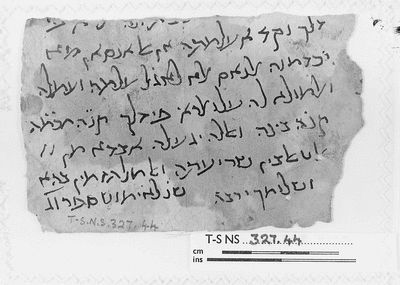
T-S NS 327.44, the disputed Maimonides autograph In Genizah Fragments, No. 44 (October 2002), and in a longer account in the Festschrift for Alexander Fodor (Budapest, 2001), Dr Avihai Shivtiel, Senior Research Associate in the Taylor-Schechter Genizah Research Unit, announced what he believed to be a new autograph by Maimonides in T-S NS 327.44. That attribution is here disputed by Professor Joel L. Kraemer, John Henry Barrows Professor of Jewish Studies in the University of Chicago, who argues that, in the final analysis, the issue centres on questions of orthography and paleography. Dr Shivtiel's response appears further on. The brief text in T-S NS 327.44 has neither heading nor signature, but Dr Shivtiel claims that "there seems little doubt about the identity of the writer." If this were so, it would certainly be, as he says, "a real cause for celebration." In my opinion, however, the fragment does not appear to be a Maimonides autograph. Dr Shivtiel's reasons for considering it to be in Maimonides's handwriting are as follows: 1. The semi-cursive handwriting appears identical to Maimonides's writing in other autograph documents. (In the Fodor Festschrift, Dr Shivtiel mentions especially a, b, t, and the ligature al- as characteristic of Maimonides.) 2. Maimonides regularly uses the concluding formula u-shelomkha yirbeh ("may your well-being increase") in his letters and responsa, or (in the longer account) he "more than others" ended his letters and responsa with this and similar expressions. 3. Dr Shivtiel finds "especially conclusive" the statement that "a person is judged by people in accordance with his deeds and his knowledge," a view, he says, that is expressly stated by Maimonides in his Mishneh Torah, Teshuvah 4:4 and 9:1. 4. In the Festschrift article, Dr Shivtiel adds another criterion, namely, that Maimonides's letters, except for the communal epistles, are concise and succinct. The issue whether this is a Maimonides autograph comes down, in the final analysis, to orthography and paleography; the other criteria are too general to be helpful. The concluding formula (u-shelomkha yirbeh, etc.) is commonplace and not specific to Maimonides. As for the general idea that a person is judged in accordance with his deeds and his knowledge, the sources cited do not actually say this. Moreover, the writer of T-S NS 327.44 is not referring to a citation but is rather saying, "I have already informed him [you] " (or, "I hereby inform you"). So writes Professor M. A. Friedman of Tel Aviv University, who also questions the ascription to Maimonides, in a communication to me. In one of his responsa (ed. J. Blau, Vol. 2, No. 268), Maimonides classifies Hebrew scripts as 1. square, or ashuri, which he calls mujallas ("settled," "seated," "sedate" [Blau: meyushav]); 2. "connected" (mu`allaq), or cursive; and 3. intermediate (mudhabdhab, "vacillating"), or semi-cursive, where the letters are discrete and only partially joined. Maimonides used a cursive script in draft versions of his works and for ephemeral writing, such as brief notes. We have excellent examples of this in texts of his three major works and his responsa. He used the intermediate or semi-cursive script in more formal writing, as in private letters; and he used the square script when he wrote a Torah scroll (Mishneh Torah, Sefer Torah 8:4 and 10:10). The chapter headings in the fair copy of the Commentary on the Mishnah (ed. R. Edelmann, Copenhagen, 1966) appear to be in his square script. His semi-cursive in the fair copy is rounded and discrete, with few ligatures and ample space between words. A driving passion of Maimonides was for clarity, order and simplicity, and this is expressed in his handwriting. He was, however, commonly pressed for time, and his hand often veers from a discrete semi-cursive to a connected cursive. Maimonides had a distinctive handwriting, which became a family ideograph. His brother David's handwriting was similar, probably because their father taught them both. And the handwriting of his son Abraham, and of his descendants down to David II ben Joshua, is equally similar to his own, as fathers from generation to generation taught their sons calligraphy. We must look for characteristic paleographic features in Maimonides's semi-cursive script, where it tends to lean slightly to the right. In T-S NS 327.44, the writing leans to the left, so that even when letters resemble Maimonides's script, such as the lamed, they tilt in the wrong direction. Handwriting experts emphasize the angle of the writing because it reflects personality and is hard to change; the space between the letters is, moreover, wider in T-S NS 327.44 than in Maimonides's writing. This is another characteristic that tends to change little, even when a person is writing in different styles or is in a hurry. Maimonides's he is very idiosyncratic. When linked to the previous letter, it is a loop (as in his own signature) and resembles the final Arabic ha'. When independent, the left stroke of the he is connected to the right one, much like a modern cursive bet. The reason for this idiosyncrasy is that Maimonides did not lift his pen from the paper but, after writing the right stroke from top to bottom, he continued with the left stroke without a break. His tav so closely resembles his he that the two are often indistinguishable, although the left stroke of the tav normally extends further to the left. These two letters in Dr Shivtiel's document are more standard. Maimonides's semi-cursive alef looks like a Greek kappa. The left vertical stroke is straight, or slightly oblique, and the right side has an angular <. (His cursive alef differs, and looks like an Arabic hamza.) The alef normally does not have pronounced spurs on the shafts of the right angle, as in the newly discovered document. His lamed has a vertical stem that usually leans slightly to the right, and sometimes has a slight spur at the top. The base is, as a rule, gently curved but it can be hunched, and is more so in his cursive script. The lamed of T-S NS 327.44 is similar, but the stem leans considerably forward. The samekh in Maimonides autographs is oval in shape, with a vertical stroke on the left that extends a little above and below the horizontal strokes, resembling a final mem in modern Hebrew script. The samekh in the new document has a long tail on its left side. Maimonides's shin is delicate and looks almost like "Rashi script". The shin of the new document is wide and rounded. The paleography of the greeting u-shelomkha yirbeh is clearly different from the same words in Maimonides autographs, such as T-S 10J20.5, T-S 12.192, T-S 12.832, and T-S AS 149.41. (He usually writes u-shelomah yirbeh, as addressed to al-hadra, or hadrat.) As for orthography, Maimonides placed three dots over the tav to signify Arabic tha' and two dots over the tav to indicate Arabic ta'; he rarely used a single dot for the tha', which was a more common technique. And he used diacritics over gimel, sade and tet to indicate Arabic jim, dad and za', although not consistently. Concerning the decipherment, the first word
in line 2 of the fragment should probably be read as
yakhdumuhu and not yukrimuhu. The
writer's resh is more rounded and his dalet more angular.
The fourth word in line 4 should be transcribed as
Dr Shivtiel is to be commended for citing an interesting document and for turning our attention to a further consideration of Maimonides autographs. 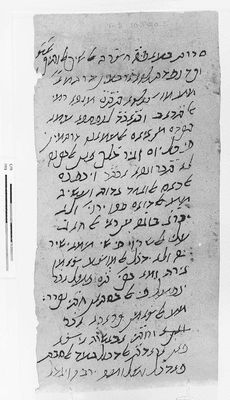
T-S 10J20.5, a letter from Maimonides about synagogue finance Genizah featured on Radio 4Edward Stourton, one of the regular presenters of BBC Radio 4's early-morning news programme, "Today", visited the Genizah Research Unit at the end of January. Accompanied by his producer, Phil Pegum, he interviewed the Unit's Director, Professor Stefan Reif, about Jewish life in the Middle Ages, especially as reflected in documents from the Cairo Genizah, and viewed a selection of the fragments prepared by researchers in the Unit. The interview revolved round the social, economic and cultural achievements of medieval Jews in large communities such as that of Egypt, and touched on the relationships between the Jews of the land of Israel and those in the widespread and varied diaspora. Some of the more unusual Genizah discoveries were discussed, with particular attention being paid to the life and work of Moses Maimonides, the leading figure of Cairo Jewry in the twelfth century. The interview was related to a series of four programmes being broadcast by BBC Radio 4 on consecutive Monday evenings from 7 April. Each deals with a different aspect of Jewish history. The programmes, entitled "In the Footsteps of Moses", are each scheduled to begin at 8 p.m. 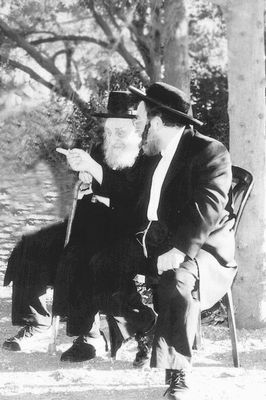
With the recent death, in Jerusalem, of Rabbi Aaron Joseph Wertheimer (pictured above, left), another link with the world of Solomon Schechter and the early Genizah discoveries has been severed. Rabbi Wertheimer, born in 1916, was strongly influenced in his upbringing by his grandfather, Rabbi Solomon Aaron Wertheimer (1866--1935), renowned for the important part he played, in the early 1890s, in publishing and disseminating Hebrew manuscript fragments from Cairo. It was Rabbi Solomon who corresponded with Schechter and the Cambridge University Librarian, Francis Jenkinson, before Schechter's trip to Cairo in 1896--97, and who sold the Library some of its first Genizah fragments. His grandson, Rabbi Aaron, followed in his scholarly footsteps, publishing revised and enlarged editions of some of his grandfather's manuscript-based works (including Batei Midrashot), and taking a keen interest in manuscript research. Avihai Shivtiel cites further reasons for document findings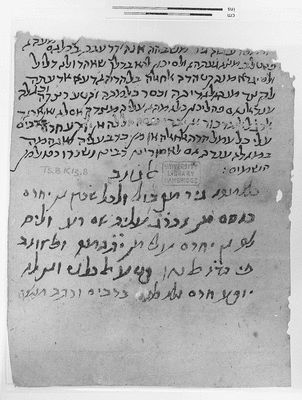
T-S 8K13.8, a responsum by Maimonides on sexual slander I am grateful to Professor Joel Kraemer for his erudite comments on my article regarding T-S NS 327.44. Kraemer bases his refutation of my claim that the document under discussion is one of Maimonides's unknown letters on differences between Maimonides's orthography and paleography here and those used in other autographs known to us. He does, however, admit that Maimonides "was also commonly pressed for time, and his hand often veers from a discrete semi-cursive to a connected cursive". I agree with this, and would add that, even in his formal writing, Maimonides's handwriting is not "monolithic". For example, in T-S 12.192 --- which is without doubt by him, and is one of the finest examples of his intermediate or semi-cursive writing --- the shape of several letters is different. Thus, the alef in the words atala allah baqa' is totally different from the alef in the words mujilluha and bu'diha; the qof in the words baqa', al-thiqa and, further down, al-maqdura, clearly shows three variations; and the two lameds in the word li-yukallif, as well as some other lameds, are completely different --- not to mention the letter he, which has several shapes in the same text. On the other hand, many letters in the "old" and the "new" documents are identical --- for example, the gimmel, tet, mem, `ayin and others. The variations in Maimonides's autographs may guide us to the logical conclusion that he, like most people, was more interested in content than calligraphy. It is clear that he was often pressed for time and that this was reflected in his handwriting, and that differences were also brought about by circumstances, mood and period. I studied and compared all available Maimonides autographs in the T-S Genizah Collection before reaching my conclusion as to the identity of the writer. Had it been only because of the handwriting, however, I would have hesitated to suggest that the document was written by him. What was more persuasive were the other points mentioned in my articles. The concluding formula used in his responsa is ve-khatav moshe. (In Blau's edition I found only two out of 400 responsa concluding with u-shlomo yirbeh (p.91) and u-shlom hadrato yarum ve-yigdal (p.103).) If, on the other hand, Professor Kraemer examines the concluding formulas in I. Shailat's edition of Maimonides's letters, as well as in the Bar-Ilan Responsa Project, he will find that u-shlomkha is used five times (possibly six; see Shailat, p.562), and that u-shlomo, u-shlomkhem, u-shlom... and shalom each appears three times. Maimonides's view that a man is revered by his deeds and knowledge is clearly stated in his Hilkhot Teshuvah 4:4. In 9:1, he emphasizes that the great deeds of a man and his wide knowledge (=wisdom) will win him a place in the world to come. That is to say, the appreciation of those qualities in a man is demonstrated not only by people but by God Himself. The translation of a`lamtuhu and al-mawla, as if referring to the addressee, makes no sense. Maimonides knew his grammar. Had he wished "to inform" the addressee, he is more likely to have used the expression u`allimuka bihi, as in his letter to his brother (see T-S 12.203). Moreover, had Maimonides sought to use the form of the third person, he would have used the concluding formula u-shlomoh or u-shlom... rather than the second-person u-shlomkha. Also, the word mawlaya is usually used in direct approach, meaning "Sir", while the word al-mawla customarily refers to "the Lord". I am grateful to Professor Kraemer for his correct reading of the word abadan, as in the original. Unfortunately, I did not spot this typographical error until after my article appeared in Fodor's Festschrift. In sum, Professor Kraemer's comments do not persuade me to change my mind about identifying the writer of the new document. 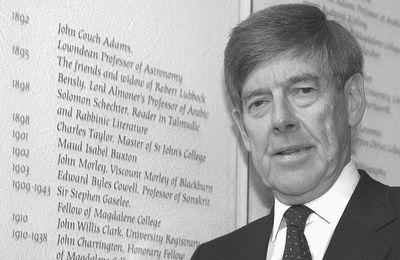
The Vice-Chancellor of the University of Cambridge, Sir Alec Broers, at the dedication of the benefactors' wall in the entrance hall of the University Library. It includes the names of Solomon Schechter and Charles Taylor (Master of St John's College), who presented the Genizah Collection in 1898. The earliest gift recorded is from Nigel de Thornton in about 1278 From the Editor's deskMore ties with North America If Genizah study was once an exclusive domain, in which a few devoted specialists exchanged technical details with each other, that situation has undoubtedly been altered beyond recognition by the developments of recent years. The study of these exciting medieval Jewish documents now has broad educational and cultural ramifications, as was confirmed for me during a recent visit to North America. I had no sooner planned my flight to Toronto when I received e-mail from Sheldon Kirshner, of the Canadian Jewish News, seeking an interview. During our meeting, Mr Kirshner asked about the personalities and motivations of those who had been involved in Genizah research, and how their discoveries had led to new perspectives on Jewish religious and literary history. He was also interested to learn whether there were any parallels between the Near East of Crusader times and the politics of that region in our own era. His article is expected to appear shortly. My visit to the University of Waterloo, about an hour to the west of Toronto, highlighted other aspects of the current Genizah story. Having enjoyed a lively lunch with Dov Friedberg, the outstanding philanthropist who set up the Friedberg Genizah Project, I also met those (among them, Professors James Diamond and Paul Socken) who are ensuring that the Project's new base at Waterloo proves to be efficiently and enthusiastically supportive of various projects around the world. These efforts relate to the decipherment and description of fragments as well as to conservation, electronic information, bibliography and digitization. In the technical areas, Waterloo may be especially well qualified to assist other institutions. My lecture there was attended by an audience with a great variety of interests and professional commitments, from both inside and outside the academic community. Those who attended another lecture of mine, at the University of Toronto, were again from a varied background and included Palestinian Arabs as well as Israeli Jews. In a fascinating meeting with David Thomson, of the Thomson Organization and the Woodbridge Company, we discussed the value of special collections and archives for further education, and the role of the media in disseminating the relevant information. Public relations was the theme of my meeting with officials at the British Consulate in Chicago, where we explored how the results of Genizah research could be widely conveyed within the context of British cultural promotions in the Mid-West. I also had the pleasure of meeting in Chicago collectors of rare manuscripts and printed items (including Genizah fragments) with whom I exchanged views on decipherment, conservation and study. This April, I am spending a few days in New York, giving lectures and having meetings, and I anticipate a similar degree of interest, variety and inspiration. Stefan C. Reif Tributes to Professor KleinA memorial meeting for Professor Michael Klein was held before a capacity audience at the Hebrew Union College's Jerusalem campus on 2 January, under the chairmanship of its current Dean, Rabbi Michael Marmur. Klein was a regular visitor to the Genizah Research Unit and had spent time in Cambridge as a Visiting Scholar at St John's College and Clare Hall. He researched and published numerous Genizah fragments and contributed a complete volume, Targumic Manuscripts in the Cambridge Genizah Collections (Cambridge, 1992), to the "Genizah Series" published by Cambridge University Press for Cambridge University Library. His final article was included in the latest number in the "Genizah Series", The Cambridge Genizah Collections: Their Contents and Significance (2002). At the memorial meeting, lectures were delivered by Professor Michael Meyer, of the Hebrew Union College in Cincinnati, and Professor Stefan Reif. Musical interludes were performed by Professor Klein's son Matan (flute) and his colleague Yuval Cohen (piano), and by Professor Eliyahu Schleifer (tenor). Mrs Shulie Reif presented a copy of The Cambridge Genizah Collections, which had been dedicated to Professor Klein's memory, to his widow, Shoshana. Penn boost for online catalogueMeeting in Denver, Colorado, in June 2002, the Association of Jewish Libraries' annual convention brought together more than 250 librarians from the United States and abroad. Over a period of five days, they attended programmes on a range of topics relating to Judaica librarianship, bibliography and booklore. At a session on cataloguing issues, Seth Jerchower, of the Center for Advanced Judaic Studies at the University of Pennsylvania, and Heidi Lerner, of the Stanford University Libraries, discussed user access and the retrieval of Cairo Genizah fragments. Describing the issues and difficulties specific to Genizah cataloguing, they drew attention to the collaborative project between the Taylor-Schechter Genizah Research Unit at Cambridge and the University of Pennsylvania Library. The project is the first step in an endeavour to digitize, catalogue and provide online access to their joint holdings of Genizah fragments. The library of the University of Pennsylvania's Center for Advanced Judaic Studies houses 517 manuscript fragments, 487 of which were first catalogued by Benzion Halper in his Descriptive Catalogue of Genizah Fragments in Philadelphia (Dropsie College, Philadelphia, 1924). An additional thirty fragments were later obtained. This discrete but important collection, which includes a tenth/eleventh-century Passover Haggadah of the Palestinian rite and holographs of Abraham, son of Moses Maimonides, is the basis for the pilot phase of the project. The project aims at creating bibliographic records for the fragments that can be integrated into both a local online catalogue and a central database covering the entire Genizah holdings, and at incorporating high-quality digitized images of the fragments, establishing, in effect, a virtual reconstruction of the Genizah. To this end, the teams from the T-S Genizah Research Unit and the University of Pennsylvania Library --- including librarians, software and application developers, and scholars --- have developed a database scheme adapting MARC (Machine Readable Cataloguing) tags, an internationally accepted encoding format for bibliographic data. The records will use the authorized name, title and subject headings of the Library of Congress's National Authority File, intended to provide controlled subject access to the fragments. As a result, the project will participate in the establishment of new headings compliant with AACR2, the standard used by the Library of Congress. Jerchower gave an overview of extant catalogues of Genizah fragments by history and type, noting their various levels of adequacy for description and indexing. Paper-based catalogues contain data that he defines as "static". By contrast, an electronic catalogue, of the type being developed by Cambridge and Penn, contains "dynamic" data, which allows for continual inputting and updating of records, and provides powerful search capabilities. Lerner reported on the technical design of the University of Pennsylvania's online catalogue of its Genizah fragments. She described the methods and standards being used to prepare electronic descriptions of the fragments at the University of Pennsylvania. Lerner examined the types of information, or metadata, required to describe manuscript fragments and showed how MARC tags are being employed to index such elements. In addition, issues such as electronic character encoding and the handling of multilingual documents were addressed. The presentation concluded with sample images of digitized fragments, demonstrating solutions to the integration of very high resolution and resizable images in an online environment. Funding aids T-S Unit projectsThe Unit's income from external sources in the current year has so far risen to over £185,000. This has made possible the engagement of four full-time and three part-time researchers, a part-time technician, and an occasional consultant. In addition to receiving the promised contributions of the Friedberg Genizah Project, the University of Pennsylvania and the John S. Cohen Foundation, the T-S Unit benefited this year from a major award made by the Athelney Charitable Trust, from the estate of the late Dr A. A. Perelmann. Dr Perelmann was a physicist and metallurgist, a multi-lingual polymath and an observant Jew, with a photographic knowledge of Jewish sources. The funds are to be used for the development of the Unit's website, the employment of young researchers, and the purchase of much-needed digital equipment. Contributions of £3,000 and £2,500, respectively, were received from the Lauffer Family Trust and the Samuel Sebba Charitable Trust; the Cyril and Betty Stein Charitable Trust and the Kohn Foundation each made a gift of £500; and £438 was donated in memory of Dr Haskell Isaacs by his family and friends. Other gifts were received from the F. and D. Worms Charitable Trust (£300); the United Mizrahi Bank (£250); Ruth and Michael Phillips (£250); Ingrid and David Sellman (£200); the Association of Jews from Egypt (£150); the University of Durham's Jewish Studies Seminar (£150); the George Balint Charitable Trust (£150); Diana and Anthony Rau (£150); and the Rubin Foundation Charitable Trust (£150). Mr H. E. Knobil, Mr John Minkes (with Rabbi Elaina Rothman), Mr Geoffrey Ognall, Mr Michael Rose and Mr Leo Sterling each kindly contributed £100. Recent supporters in the USA and Canada included Roger and Julie Baskes ($1,000), Professor Benjamin M. Friedman ($500), Congregation B'nai Israel of Basking Ridge, New Jersey ($500), Mr Daniel Schechter ($200), Professor Joel Kraemer ($180), and Dr Barry Mittelman ($100). Additional gifts of $100 were made by Mrs Anne S. Herzberg in memory of Jeanne and Morris Schechter and by Cynthia and Karl Bielak in memory of Mrs Annie (Reif) Baum. There were also smaller and anonymous donations totalling over £1,200. How you can helpIf you would like to receive Genizah Fragments regularly, to enquire about the Taylor-Schechter Genizah Collection, or to know how you may assist with its preservation and study, please write to: Professor S. C. Reif, Director of the Taylor-Schechter Genizah Research Unit, at Cambridge University Library, West Road, Cambridge, CB3 9DR, England. The Library may also be reached by fax (01223) 333160, or by telephone (01223) 333000. The Internet access is at http:// www.lib.cam.ac.uk/Taylor-Schechter. Enquiries by e-mail should be addressed to genizah@lib.cam.ac.uk. All contributions to the Unit, whether for the research programme or for its other activities, are made to the ''University of Cambridge'', which enjoys charitable status for tax and similar purposes. In the USA, ''Cambridge in America'' supports the Taylor-Schechter Collection with its unfunded grant number 7/78. If you are interested in supporting this project, please contact the Director of the Annual Appeal at: 309 West 49th Street, New York, NY 10019-7399 (tel: 212-984-0960). ''Cambridge in America'' is recognized by the IRS as a charitable organization, and contributions are legally deductible for USA income tax purposes. Contributions are similarly deductible in Canada even if made directly to Cambridge. The cost of producing this issue of Genizah Fragments has kindly been defrayed by the family of the late David Lauffer. David was enthusiastic about the study of Jewish history and was intrigued by the manner in which the Genizah material could illuminate its dark corners. He is fondly remembered in the Genizah Research Unit as a generous supporter over a number of years. |
Edited by Stefan C. Reif
If you have any questions, please e-mail
genizah@lib.cam.ac.uk
Return to the Genizah Fragments index
Return to the Taylor-Schechter Home Page
Return to Cambridge University Library's Home
Page